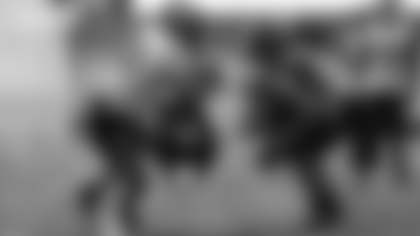Let's get to it:
JEFF BOSETTI FROM LATROBE, PA: When Ben Roethlisberger was inserted into the starting quarterback role, Coach Bill Cowher focused the offense on running the ball to limit the amount of his throws. Why aren't the Steelers taking the same approach with Kenny Pickett since we have the talent? Even the Tennessee Titans did it this way when they started Malik Willis this past week, so it seems like the right approach for a rookie.
ANSWER: I don't disagree with this premise in principle, but the comparisons are nowhere near apples-to-apples.
The 2004 Steelers really had no intention of playing Ben Roethlisberger during his rookie season, because they went to training camp with Tommy Maddox as the incumbent starter and veteran Charlie Batch as the clear No. 2. But then Batch injured a knee early in training camp and had to go on injured reserve, and then Maddox was knocked out of the game against the Ravens on the second weekend of the regular season with an injury to his right arm. Leading up to all of that, Coach Bill Cowher was able to use all of training camp and the preseason to "re-establish the mindset," which was his code for returning the offense to the physical style that had been a franchise staple for so many years. That 2004 training camp contained two-a-days and lots of hitting (neither of which are allowed under today's Collective Bargaining Agreement), and that offensive line had a first-team All-Pro at center (Jeff Hartings), a future Hall of Famer at left guard (Alan Faneca), and a veteran No. 2 pick at left tackle (Marvel Smith). Also, there was a one-two punch at running back in Duce Staley, an unrestricted free agent signing who came to Pittsburgh with three 1,000-yard seasons on his resume, and Jerome Bettis, who would end up in the Pro Football Hall of Fame. It's also important to remember that there were no limitations on the number of padded practices during the regular season, as is the case now, and so those Steelers were hitting a couple of days a week, every week of the regular season.
And as for the Titans, they have Derrick Henry and have been pounding the football with him ever since he came into the NFL in 2016, and so they're built for that and have been practicing that style for years.
Limiting Pickett's exposure to the pass rush and reducing the number of hits he takes should be a priority for the rest of this regular season but expecting a middle-of-the-season change in strategy to a physical running attack to have the same results as it did in 2004 for the Steelers or on Oct. 30, 2022, with the Titans I believe is pie-in-the-sky. It's still worth trying, though.
- Download and listen to the Ask & Answered Podcast here:Apple Podcast| Spotify
SHAWN WILLIAMS FROM YOUNGSTOWN, OH: While we're still in the rookie season of Kenny Pickett's career, if we did end the season with a top-5 draft pick, do we take a quarterback who has a higher draft grade just to have all options on the table, or are we now fully committed to Kenny for the foreseeable future of his rookie contract?
ANSWER: Picking a quarterback 20th overall and then using a top-5 pick in the very next draft on another quarterback would be the football version of malpractice. If a team wasn't sure about the quarterback it picked 20th overall having the potential to be a quality NFL starter, then it shouldn't have drafted him in the first place. Draft picks are too valuable – and premium picks in the first round even more so – to spend them in back-to-back years on a position where only one player at that position plays at a time.
JEFF BANKOVICH FROM ELIZABETH TOWNSHIP, PA: Let's say the Steelers have a losing record, but they finish with a 5-1 record in the AFC North Division, would they qualify for the playoffs?
ANSWER: When it comes to determining which team from a particular division wins the division and gets the automatic bid to the playoffs, the first criteria is overall record. The tiebreaker factors – such as head-to-head, record vs. division opponents, etc. – don't come into play unless two or more teams are tied atop the division with the same overall record. Based on your question, the Steelers would finish the season with an overall losing record, and so I doubt that the tiebreakers would get the chance to be a factor.
KEVIN WALTERMIRE FROM HAMPTON, VA: Coach Mike Tomlin is taking a lot of heat for how bad this team is. After Terry Bradshaw retired, how bad was the team the following year?
ANSWER: Terry Bradshaw retired following the 1983 season, and the 1984 Steelers won the last two games of that regular season by a combined 9 points to finish 9-7 and win the AFC Central Division. They then upset the heavily favored Broncos in Denver in the Divisional Round to advance to the AFC Championship Game in Miami where Dan Marino's Dolphins spanked them, 45-28. Then, in three of the next four seasons, the Steelers finished 7-9, 6-10, and 5-11.
BRENT PASSINO FROM COLDWATER, MI: When injured, is a player required to see the team doctor or can that player refuse and see only his choice of doctor? Does a player require clearance from the team doctor to play, or could he return to play based on the opinion of his own doctor?
ANSWER: Because of the fact the vast majority of players are injured during a game or during a practice, the team's medical staff is usually the first to tend to an injured player, because those people are on the scene. But before the player decides on any course of treatment, he is free to seek outside opinions, and then he is free to have any procedures performed by the doctor who provided the outside opinion if he so chooses. As one example, Ben Roethlisberger had surgery performed on his right elbow in Los Angeles. As for signing off on a return to play, any of the medical professionals involved with athletes at this level are familiar with recovery time and rehabilitation, and often there will be some agreement among them in terms of a date for return to play. It's not a confrontational situation, because everyone involved is most interested in the patient's well-being.
IAN BAGNELL FROM BRIGHT'S GROVE, ONTARIO, CANADA: I found the question on Steelers quarterbacks taken in the first round over time interesting. I was wondering how many times the Steelers have taken a running back in the first round, and who they were.
ANSWER: The first thing to understand is that the Steelers were the last NFL team to switch to a T-formation on offense, and before that they ran the single-wing. And once they switched to a T-formation, there was a halfback and a fullback on the field at all times, and so those two positions are included in the following list. And I decided only to go back to 1950, because, well, just because.
1950 – Lynn Chandnois; 1951 – Butch Avinger; 1952 – Ed Modzelewski; 1954 – Johnny Lattner; 1960 – Jack Spikes; 1962 – Bob Ferguson; 1966 – Dick Leftridge; 1967 – Don Shy; 1972 – Franco Harris; 1979 – Greg Hawthorne; 1982 – Walter Abercrombie; 1989 – Tim Worley; 2008 – Rashard Mendenhall; 2021 – Najee Harris.
CHRIS GALLOWAY FROM FATE, TX: What are your thoughts on Chase Claypool being traded?
ANSWER: What surprised me was that there was a team willing to give the Steelers more than they had spent to draft him in 2020. Chase Claypool was the 49th overall pick in the 2020 NFL Draft, and the Bears sent their second-round pick to the Steelers to acquire him. The Bears currently are 3-5, and unless they turn it around in the second half of this season, there is a good chance that No. 2 pick could be in the top 10 in every round, and the Steelers originally got Claypool with the 17th pick in the second round. Using scouts' slang, that was a "Godfather offer," meaning that it was an offer they couldn't refuse.
GLENN SMITH from FAYETTEVILLE, NC: Have the Steelers ever traded back in round 1 of an NFL draft to get more picks? If so, what year did that take place and who did they select with the extra picks?
ANSWER: Since the 1970 NFL-AFL merger, the Steelers have traded down in the first round of the draft twice – in 1990 and in 2001 – and just to be clear, they only traded down because they knew the player they wanted to pick would still be available and they could get something extra in return. Since Chuck Noll was hired in 1969, the Steelers never have traded down in the first round simply to accumulate more picks.
In 1990, the Steelers traded their 17th overall pick to Dallas for the Cowboys' 21st overall pick plus a pick in the third round. The Steelers used the No. 21 pick to select tight end Eric Green from Liberty, and with that extra third-round pick they selected defensive lineman Craig Veasey from the University of Houston. With the No. 17 overall pick, the Cowboys selected Florida running back Emmitt Smith.
In 2001, the Steelers traded their 16th overall pick to the Jets for their 19th overall pick, plus extra choices in the 4th and 6th rounds. The Steelers used the No. 19 pick to select nose tackle Casey Hampton, and with the extra picks in the fourth and sixth rounds they selected offensive tackle Mathias Nkwenti and defensive end Rodney Bailey, respectively. With the No. 16 overall pick, the Jets selected wide receiver Santana Moss.
GREG PORTER FROM WHEELING, WV: The Steelers run the ball out of the shotgun formation a lot. Do you think it would be worth a try to change it up and have Najee Harris get the ball moving forward with a full head of steam? Also, what about using a fullback for him to follow, or have Harris and Jaylen Warren in the backfield together to provide the defense with a different look?
ANSWER: I wouldn't be opposed to any of that, but you couldn't just put Kenny Pickett under center and then run the ball, because that would tip the defense to what was coming, just as you couldn't only run the ball every time Derek Watt came onto the field for the same reason. Running a split-backfield would require more work, I believe, because NFL teams don't operate that way anymore, so I don't know how practical/worthwhile it would be to try to implement that in the middle of a season.
DANIEL PINCHOK FROM WASHINGTON, PA: During the Philadelphia game on Oct. 30, the Steelers were flagged for an illegal formation on a kickoff. How does that happen?
ANSWER: A few years ago, in the interest of player safety, a rule was adopted where the kickoff team had to line up with a certain number of players on either side of the kicker, and the kicking team also had to have players only a certain distance behind the 35-yard line to prevent them from building up to speed before the ball was kicked. Maybe the Steelers were in violation of one of those rules, or a more likely explanation is that the referee blew the call, because the Steelers were lined up the exact same way for every kickoff but were flagged for illegal formation only once.














